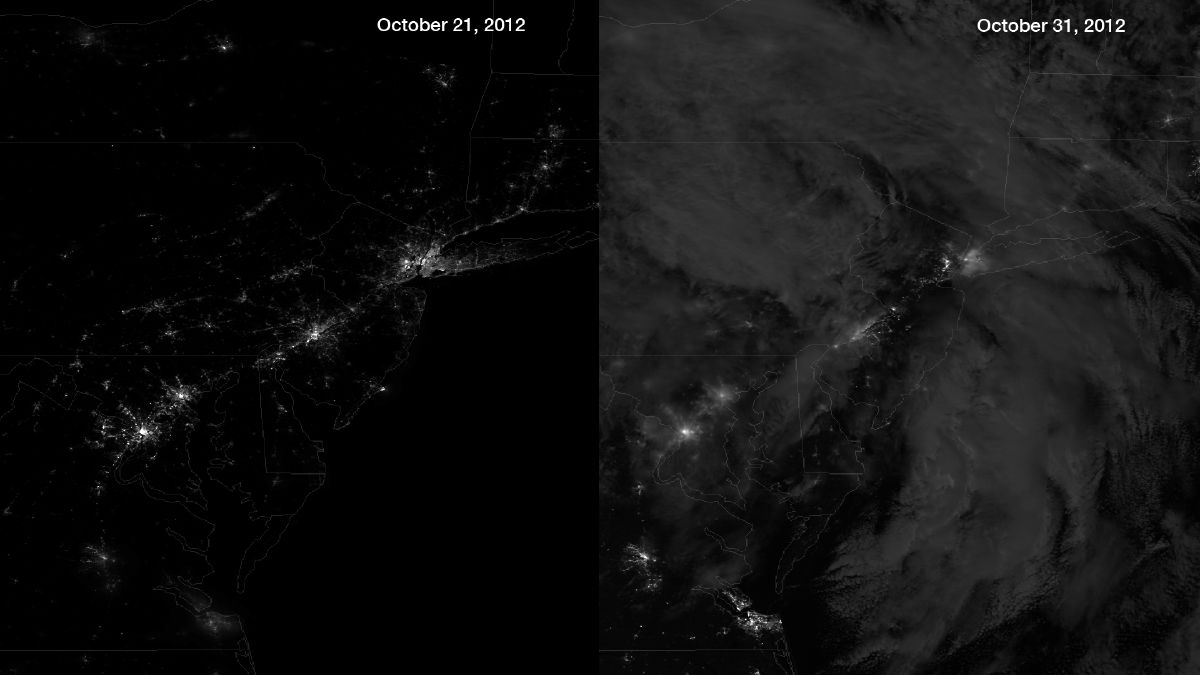New York's Power Outages Offer Rare Stargazing Opportunity

The widespread power outages that have enveloped the New York City tri-state area in the wake of Hurricane Sandy may have one silver lining, at least for stargazers.
The Metropolitan New York area is generally considered to be the most light-polluted region of the United States and probably one of the worst places in the country to do any serious skywatching (other than perhaps viewing the moon and some of the brighter planets).
But the lack of electricity has plunged a large portion of this area into unaccustomed nighttime darkness and could provide city dwellers a chance to see some sights that are not often available in these normally washed-out urban skies. [November 2012 Night Sky Guide (Sky Map Gallery)]
Past outages
Since 1965, New York has had three major power blackouts. But of those three, in two cases the night sky still wasn't optimal, because astronomy enthusiasts had to contend with the moon.
On Nov. 9, 1965, a blackout that hit the northeast United States came on the night after a full moon. As a result, the sky was illuminated to such a degree that only the brightest stars and constellations were visible; a saving grace for those unaccustomed to darkness, but a bane to those hoping to get a glimpse of many of the fainter stars.
On July 13, 1977, the New York area was blacked out for 25 hours when lightning hit an electrical power plant in nearby Westchester. Unlike in 1965, however, the moon was a slender crescent in the predawn sky, allowing even those in Manhattan to get a rare glimpse of the Milky Way.
Breaking space news, the latest updates on rocket launches, skywatching events and more!
More recently, a massive power failure blacked out a large section of real estate from the eastern Great Lakes into New England on Aug. 14, 2003. But once again, the moon was just two days past full and effectively squelched many of the dimmer stars.
Anyone in New York City or adjacent New Jersey and Connecticut who might try getting a view of a dark sky this weekend should do so early in the evening, because the moon will again be a factor. Currently, the moon is a waning gibbous phase and still rather bright, potentially washing out dimmer objects. On Friday night (Nov. 2), the moon will rise around 8:40 p.m. local daylight time. On Saturday (Nov. 3), it will rise around 9:30 p.m. and on Sunday (Nov. 4), the first night back on standard time, it will again rise at around 9:30 p.m.
What's on view
The autumn sky is generally rather dull compared to the other seasons, because it contains many dim, faint stars, so having access to a darker sky certainly will be an advantage.
High in the north, the famous zigzag row of five stars marking the constellation of queen Cassiopeia will be prominent, while high in the south, the famous 'Great Square' of Pegasus will be evident as well. Perhaps you might scan that part of the sky to the upper left of the Square to find the most distant object you can glimpse with your unaided eye from a dark, clear location: the famous Andromeda Galaxy. It appears as a small, dim elongated patch of light — dim because it's about 2.5 million light-years from us!
High toward the west, the famous Summer Triangle, composed of the bright stars Vega, Deneb and Altair, can still be seen, while low in the east, some of the bright stars of winter will be emerging, along with a brilliant planet, Jupiter, resembling a slivery, non-twinkling star.
And be on the watch for meteors and possibly even an outstandingly bright meteor (called a fireball) emanating from the eastern part of the sky. This upcoming week will be the week to watch for the annual Taurid meteor shower. The meteor rates for this shower are rather low — about 10 or 15 per hour — but they move much more slowly than the typical streak made by most meteors and appear orange or even reddish in color. This year, some larger particles may become interspersed with the regular meteor swarm, perhaps giving rise to some very bright meteors moving majestically across the sky.
So if you live around the New York area and are still in the dark, at least you can take advantage of those few hours before moonrise to see some celestial sights you ordinarily would not be able to see.
Joe Rao serves as an instructor and guest lecturer at New York's Hayden Planetarium. He writes about astronomy for The New York Times and other publications, and he is also an on-camera meteorologist for News 12 Westchester, New York.

Joe Rao is Space.com's skywatching columnist, as well as a veteran meteorologist and eclipse chaser who also serves as an instructor and guest lecturer at New York's Hayden Planetarium. He writes about astronomy for Natural History magazine, Sky & Telescope and other publications. Joe is an 8-time Emmy-nominated meteorologist who served the Putnam Valley region of New York for over 21 years. You can find him on Twitter and YouTube tracking lunar and solar eclipses, meteor showers and more. To find out Joe's latest project, visit him on Twitter.
